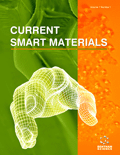Abstract
Background: Polymer gel electrolytes have attracted much intention due to their high ionic conductivity (10-2 - 10-3 S/cm) along with other suitable properties like good thermal stability, compatibility with electrode materials, easy workability, wider control of properties etc. These materials are also called smart materials due to their practical applications in various devices like high energy power devices, electrochromic devices, supercapacitors, devices for Infra-red systems etc. This paper mainly discusses the enhancement of an ionic conductivity with the addition of polymer. No appreciable change in conductivity of gel electrolytes has been observed with temperature, which makes them suitable for device applications.
Methods: Liquid electrolytes were prepared by dissolving orto-nitro benzoic acid (o- NBA) in the ternary mixture of ethylene carbonate (EC), propylene carbonate (PC), and dimethylacetamide (DMA) (in 2:2:1 volume ratio). The homogeneous polymer solution of PVdF in acetone is prepared and then added to the liquid electrolyte along with continuous stirring. Polymer gel electrolytes are obtained after the evaporation of acetone. Ionic conductivity of liquid and polymer gel electrolytes is measured by HP4284A precision LCR meter (having frequency range from 20Hz-1MHz) using complex impedance spectroscopy.
Results: The conductivity of liquid electrolytes increases by two orders of magnitude with an addition of ortho-nitro benzoic acid (10-6 to 10-4 S/cm) and maximum room temperature conductivity of 1.46 x 10-4 S/cm has been obtained at 2M concentration of o-NBA in ternary mixture of EC, PC and DMA. The conductivity of electrolytes increases with the addition of polymer and maximum conductivity of 5.91 x 10-4 S/cm has been obtained at room temperature. The increase in conductivity has been explained by using “Breathing Polymer Chain Model”. Ionic transference number was calculated and it was found out to be nearly 1, which suggests that gel electrolyte is principally ionic conductor.
Conclusion: Maximum conductivity of 5.91 x 10-4 S/cm at room temperature has been observed for gel electrolyte containing 2M ortho-nitrobenzoic acid in EC:PC:DMA (2:2:1) with 8 wt% PVdF. The conductivity of polymer gel electrolytes has been found to increase with the addition of PVdF concentration. The conductivity of gel electrolytes is found to be higher than that of liquid electrolytes at all PVdF concentrations i.e. σ(gel) > σ(liquid). The increase in conductivity has been found to depend upon the concentration of acid, dissociation constant of acid and concentration of PVdF used. No appreciable change in conductivity of gel electrolytes has been observed with temperature, which make them suitable for device applications. Ionic transference number measurements suggest that these electrolytes are principally ionic conductors.
Keywords: Conductivity, dimethylacetamide, ethylene carbonate, gel, transference number.
Graphical Abstract
 28
28 2
2




